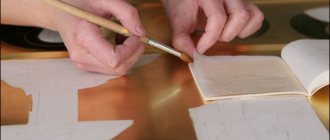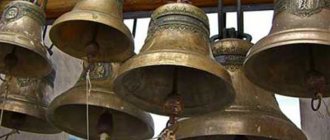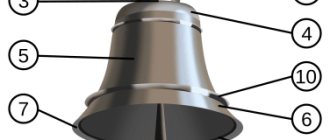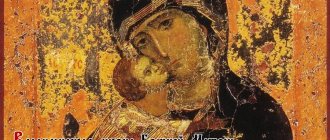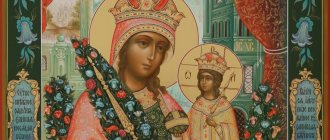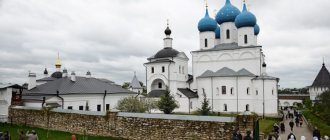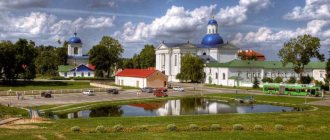At the beginning of the 20th century, the whole world learned about the existence of such a phenomenon as the Russian Icon.
Not long before this, the Russians themselves discovered it. They began to clean up the renovations on the ancient icons and remove the frames. Look even more carefully at the abandoned images that were collecting dust in the attics.
It was there, in the attic, that the “Angel of Golden Vlas” was once found. And under the salary and renovations - Rublev’s incredible “Holy Trinity”.
One day Henri Matisse came to Russia. I saw all these newly found treasures and said: “...The Russians have no idea what artistic treasures they own. Everywhere there is the same brightness and manifestation of great power of feeling. Your students have here, at home, incomparably better examples of art than abroad...”
I believe that we still have not fully realized what treasures we have. And we don’t always look into the hall of icon painting in the Tretyakov Gallery and the Russian Museum.
Therefore, I propose to take a closer look at 5 masterpieces of Russian icon painting in order to better understand the value of our heritage.
Angel of Golden Vlas. XII century. Russian Museum.
Unknown master.
Angel of Golden Vlas (Archangel Gabriel or Michael). Second half of the 12th century (origin: Veliky Novgorod). Russian Museum, St. Petersburg. Restoration.rusmuseum.ru. The “Angel of Golden Vlas” was once part of the Deesis rank. This is a group of several icons. In the middle was Christ Pantocrator. And on the left and right are icons with the Mother of God, John the Baptist and other angels and saints. They seem to ask the Son of God to forgive man his sins.
It was among such intercessors that our “Angel” was located.
Using the assist technique, his head is covered with thin strips of gold leaf. Hence the name of the icon - “Angel of Golden Vlas”.
Unfortunately, the icon has come to us in an altered form. After all, the surface was always covered with varnish, which after 100 years became very dark.
And the artists of the new era renewed the icon. No, they didn’t restore it, but painted the same image on top of a dark layer. But they often added features of the new era.
Therefore, the golden background of the “Angel of Golden Vlas” was changed to green in the 17th century. The color and outline of the Angel's robe were also changed.
But still the image itself remained almost the same.
The Russian master took the canonical Byzantine image of the Angel as a basis.
Left: Miniature depicting Archangel Michael. End of the 11th century. National Library in Paris. Ruskatolik.rf.
It would seem that the images are very similar. But still we see some features in the Russian icon.
The master enlarges and lengthens the eyes, lowering their outer corners down. In this case, the upper part of the pupils is hidden under the eyelids. The result was sad and kind eyes.
Detail of the icon “Golden Angel of Vlas”. XII century. Russian Museum, St. Petersburg. Restoration.rusmuseum.ru.
And it adds shadows to the corners of the lips, which create the illusion of a slight smile.
And this combination of sad eyes and a smile creates an incredible feeling of light, joyful sadness. These are the eyes of a loving, sympathetic and asking creature for you.
The Russian master does not simply repeat the image. He does everything to show the extraterrestrial nature of the Angel. His boundless love and willingness to forever ask for us.
Zvenigorod rank | Author unknown
The image consists of three icons and was discovered in the 1910s. in the barn of the Assumption Cathedral in a city called Zvenigorod. Researchers suggest that it was written around the 15th century.
It depicts the Savior, Archangel Michael and Apostle Paul. All images of saints are presented as sublime and spiritual, their proportions are impeccable.
At first, experts believed that the found relic of the Zvenigorod Chin belonged to the brush of the famous Russian saint icon painter Andrei Rublev, but later they agreed that its author was unknown.
Nicholas the Wonderworker. XIII century. Tretyakov Gallery.
Saint Nicholas the Wonderworker.
First half of the 13th century (origin: Veliky Novgorod). Tretyakov Gallery, Moscow. Ar.culture.ru. The icon depicts one of the most famous saints, the patron saint of sailors, the pacifier of warring parties and the savior from vain death. He blesses with one hand and holds the Gospel in the other.
The Russian master again takes on the Byzantine canon. But it adds something special. This is easy to see when comparing the two icons.
Left: St. Nicholas the Wonderworker with his life. First half of the 13th century. Monastery of St. Catherine, Sinai in Egypt. Icon-art.info.
The Novgorod artist lengthens and expands the skull, making the fingers thinner. Makes the nose very thin. At the same time, it makes the lips look fuller. All this visually endows the saint with even greater intelligence and kindness.
But the main thing is that the illusion of movement is noticeable in the face of St. Nicholas: curved eyebrows, a curl in the beard, asymmetrical eyes.
By the way, about the eyes. Notice how different the saint’s eyes really are!
Initially, this technique was taken from the Byzantines. They, in turn, adopted the ancient heritage. Even the ancient Greeks noticed how the image comes to life if you add a little asymmetry to the face. We know this thanks to the surviving Fayum portraits.
Fayum portrait of a man (fragment). 95-100 n. e. Brooklyn Museum, New York.
But the Russian master uses this technique especially freely. And he not only makes the eyes different in size, but also places one higher than the other.
The Russian master creates a unique image of a very wise man with lively eyes. They are filled with an understanding of something transcendental, inaccessible to an ordinary person.
Our Lady Hodegetria (Guide) | Author: Dionisy
The image was painted by the icon painter Dionysius around the 1480s. For a long time he stayed in the Ascension Monastery of the Moscow Kremlin. It is one of the artist's earliest works.
The icon played a major role in the interior of the cathedral for which it was painted. It depicts the Mother of God Hodegetria (Guide) and her son sitting in her arms, the faces of the saints are solemn and stern. The clothes and faces emit light; there is a considerable amount of golden color on the icon.
For reference: Such a color scheme was unusual for Russian iconography of those times. It became relevant in the 17th century and was called “Hodegetria of Sedmiezerskaya”.
Don Icon of the Mother of God*. XIV century. Tretyakov Gallery.
Don Icon of the Mother of God.
1380-1390s. Tretyakov Gallery, Moscow. Wikimedia Commons. The Mother of God holds the infant Christ in her arms. They press their cheeks to each other. Therefore, this type of icon is called Eleusa, which means “tenderness.”
This type of icon came to Rus' almost immediately after Christianity became the main religion. The first was Our Lady of Vladimir. All subsequent icons of Eleus were created in her image and likeness.
Our Lady of Vladimir. XI century (origin: Byzantium). Tretyakov Gallery, Moscow. Wikimedia Commons.
It would seem that the Russian master works according to Byzantine canons. But here too he adds a lot of his own. Jesus' legs are bare to the knees. And his ring finger is bent. All this gives him the characteristics of a real child, and not a small adult.
But the main uniqueness of this icon lies elsewhere. Byzantine masters depicted the Mother of God primarily as saddened. After all, she already knows about the fate of her son. These eyes do not look at the child, but somewhere to the side. It's as if Saint Mary is thinking about what's to come.
The Russian master makes changes: he again enlarges the eyes and enhances their asymmetry. Adds barely noticeable wrinkles to the outer corners of the eyes. The Mother of God directs her gaze to her son. It also lifts the corners of the lips upward.
As a result, a feeling is created that her gaze is filled with love, and sadness recedes. She looks at the child and smiles slightly at him. The master deliberately focuses on the love of a mother for her son.
You and I have already noticed that Russian artists sought to create images that radiate kindness and mercy. This was also the case in Byzantine icons.
But the tendency to strengthen this effect is obvious.
The fact is that for a Russian Christian the icon was very important. People came to her to pray about everything in the world. And it is easier to go not only in difficult times, but also with minor worries, to a very merciful image. Someone who understands everything will forgive everything. And most importantly, he will accept any prayer, even about the most everyday things.
The artists intuitively understood this and created for their main viewer, the believer, what he so desired.
Savior Not Made by Hands | Author: Simon Ushakov
According to legend, the icon “Savior Not Made by Hands” was the first to immortalize the image of the Lord God.
There are two versions of the origin of the image:
- on a towel (Mandylion);
- on the stone (Keramion).
Researchers found one of the first mentions of it in written sources from the 4th century. In Rus', the original of the shrine of the towel was not discovered, but in many monasteries its copies, which have miraculous powers, were and are kept.
Andrey Rublev. The Holy Trinity. XV century.
Andrey Rublev.
The Holy Trinity. 1425. Tretyakov Gallery, Moscow. Icon-art.info. Before us are three Angels. They sit around a table with only one bowl on it. Behind the angels rise a rock, a tree and a building.
This canonical image arose on the basis of the Old Testament story “The Hospitality of Abraham.”
Abraham and his wife Sarah met three strangers, beautiful young men. They invited them into the house and treated them in their garden. They also sacrificed a calf for them.
Until the 15th century, masters depicted details of this plot. At a minimum, those serving Abraham and Sarah. But Rublev made significant changes.
Let's compare his “Trinity” with a Byzantine icon.
Left: Trinity (Hospitality of Abraham). End of the 14th century. Benaki Museum, Athens. Icon-art.info.
Rublev removes Abraham and Sarah. And also all the food from the table, except for one bowl with the head of the sacrificed calf. Thus, he focuses all his attention on the three Angels.
And now “Abraham’s Hospitality” turns into an attempt to depict the Trinity of God.
The Byzantine master's angels are also very similar. And he, too, thereby tries to show that very trinity: God the Father, God the Son and the Holy Spirit are inseparable from each other.
But Rublev does it better. He combines three figures into a circular composition. And also one bowl symbolizes that same unity. After all, she is one for all! And even in the outlines of the Angels we see the cup uniting them.
Rublev deliberately does not explicitly indicate who is who. After all, the trinity of God cannot be known either by man or even by an angel.
But we will still try, because in this attempt we can hear... their conversation. But to do this you need to look very carefully at their poses and gestures.
The angel in the middle offers a cup to the one on the left (for the viewer). He says: “Accept this cup, accept the role of the sacrificial calf, and I bless you for this.” We see him leaning towards him and blessing the cup. The tree behind him also bent towards him, as a symbol of birth on Earth.
The left angel has straightened up, that is, he is ready to accept this cup. And the straight columns of the building echo it. He joyfully accepts the blessing of His Father, the chief architect of this world.
The right angel leaned forward strongly, as if assuring his readiness to support.
Rublev depicts a silent dialogue, without words and human fears and doubts. Therefore, there is a feeling of otherness.
All poses are barely different from each other, but they say a lot. Never before has such a silent and at the same time eloquent image been created.
Icon of Blessed Xenia of St. Petersburg
They began to venerate the saint during her lifetime, despite the fact that she was officially canonized in 1988. There are quite a few handwritten images of her, the most famous is in St. Petersburg, in the Smolensk Church. The saint's day of remembrance is celebrated on February 6, the day of glorification is June 6. Today parishioners ask the saint to help in the birth of children, their upbringing and education.
Dionysius. Descent into hell. XVI century. Russian Museum.
Dionysius and the workshop.
Descent into hell. 1503. Russian Museum, St. Petersburg. Icon-art.info. Before us is an icon created 80 years after the appearance of Rublev’s “Holy Trinity”. But how much Russian icon painting has changed!
Strict brevity was replaced by detail. The minimum figures were replaced by crowds. A single circular space was divided into several levels. Everything has become much more complicated. Although it has become much more entertaining in terms of looking at the details.
There are angels around Christ. And various demons in Hell. And also a motley crowd of lay people next to the saints.
What was the reason for such dramatic changes in icon painting?
The fact is that 20 years before the “Descent into Hell,” Moscow Prince Ivan III put an end to Rus'’s dependence on the Horde. The country breathed freely.
Both the prince and his close nobles wanted to perpetuate the solemnity of what was happening. After all, Rus' was straightening its shoulders and gaining strength.
It was Dionysius who heard the request and began to create majestic and solemn images. His saints are beautiful, their poses stately. He's already adding more specifics.
This inevitably meant a departure from the sublime spirituality that we saw in Rublev's The Holy Trinity.
But this was the request of society, and Dionysius masterfully followed it.
Icon of Tenderness of Pskov-Pechersk
It is a reproduction of the icon of the Mother of God of Vladimir, made in 1521. According to legend, it was she who saved Pskov from death during the siege by the troops of the Polish King Stephen in 1581. Remembrance Day is celebrated on October 7 - on this day in 1812, the Pskov-Pechersk Icon of Tenderness was in the troops of the I Corps of the Russian Army during the siege of the city of Polotsk by Napoleon’s army. The city survived then. The icon is considered miraculous; blind people have been healed more than once through prayer. Nowadays it is located in the iconostasis of the Assumption Cathedral of the Pskov-Pechersky Monastery.
Iconography after Rublev and Dionysius
In the middle of the 15th century, Byzantium fell. Russian aristocrats turned their gaze to the West. And there they saw lush baroque and incredible realism.
Of course, this amazed them. They wanted secularism and brightness in their life. This inevitably affected the icons. The Virgin Mary now has pronounced chiaroscuro, and the flat image becomes three-dimensional.
Simon Ushakov. Theotokos Eleusa of Kykkos. 1626. Tretyakov Gallery, Moscow. Wikimedia Commons.
The Holy Trinity was filled with many details and decorative patterns. And the feeling of otherness simply dissolved in them.
Holy Trinity. 1705. Hermitage, St. Petersburg. hermitagemuseum.org.
That same endless kindness and love, expressed in the language of painting by the masters of the 12th-16th centuries, faded into the background. For the sake of external detail and even decorativeness.
Rublev’s “Holy Trinity” remains the pinnacle of Russian icon painting. And no one has succeeded in creating something like this.
***
If my style of presentation is close to you and you are interested in learning painting, I can send you a free series of lessons by email. To do this, fill out a simple form using this link.
Comments
for other readers,
see below
. They are often a good addition to an article. You can also share your opinion about the painting and the artist, and also ask the author a question.
Author: Oksana Kopenkina
Go to home page
*The more common version is that the Don Icon of the Mother of God was created by Theophan the Greek. However, I adhere to V.N. Lazarev’s version that the creator is a Russian master, possibly a student of Theophanes the Greek.
Icon of the Blessed Virgin Mary of Smolensk
This icon was brought to Russia in the 11th century. It is recognized as miraculous, protecting and fencing the western borders of the country. The celebration of the icon takes place on August 10. It was delivered to Russia from Greece, however, to this day it is unknown who made it. Among the most famous miracles attributed to this icon of the Most Holy Theotokos is the fencing of Smolensk from the invasion of the army of Batu Khan in 1239. Its prototype is considered irretrievably lost during the occupation of Smolensk by Nazi troops in 1941. There are only a few lists left.
The miraculous eruption of the prophet Jonah from the mouth of a whale
The icon was painted at the end of the 18th century and is in a private collection .
The plot enjoyed some popularity in the painting of temples and in book miniatures. It has even become one of the most widespread in world art, but the “Miraculous Eruption” icon is a rarity. In addition, it is made in a special way; there is a mixture of two techniques. It is assumed that two artists, or one professional who mastered painting and icon techniques, participated in its writing.
The image is a story from the Bible. The prophet Jonah spent three days and three nights in the belly of a whale. All this time he prayed furiously, asking the Lord for salvation. The Lord heeded his prayers, the whale swam to the shore and spat out the prophet.
0 0
Transfiguration
The temple icon is located in the Transfiguration Cathedral (Yaroslavl region) .
The approximate date of creation is 1403. For a long time, Theophanes the Greek was considered the author, but later it was proven that the icon was painted by another person. Unfortunately, nothing is known about him. It is based on the gospel narrative. In the center of the composition is the Savior. To the right and left are the prophets, below are the apostles who fell on their faces.
It is customary to pray at the icon of the Transfiguration of the Lord (August 19) for the strengthening of faith, the expulsion of evil from the heart, and cleansing from sins.
The resurrected savior frees the prisoners of Dachau
"Young" icon dedicated to concentration camp prisoners .
It was written in the second half of the twentieth century. Dachau is a terrible place, thousands of people were tortured here. Opponents of the Nazi regime, mentally ill people and others “polluting the Aryan race.” In 1945, on Palm Sunday, the prisoners were released by the American army. Among the captives there were many clergy, and many sought salvation from God. A week later, Orthodox believers celebrated Easter.
In 1994, a chapel was built here. Angela Heusen (a famous icon painter) wrote five works for her. The most impressive was the icon “The Risen Savior Frees the Prisoners of Dachau.” Christ leads the prisoners through the gates, which the angels open for them.
